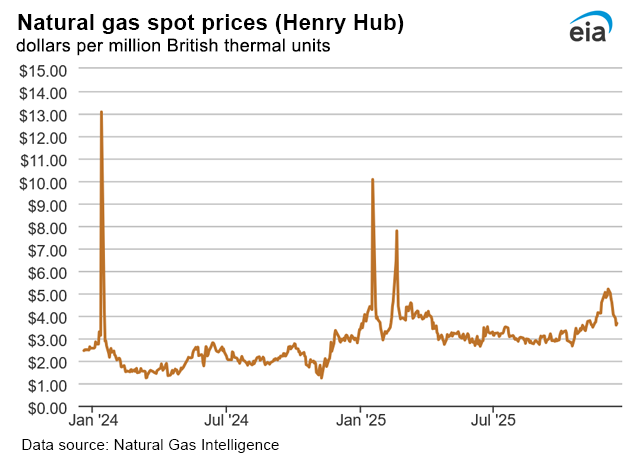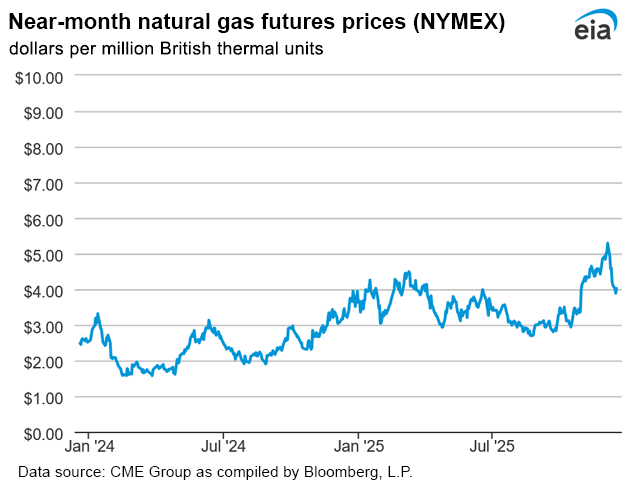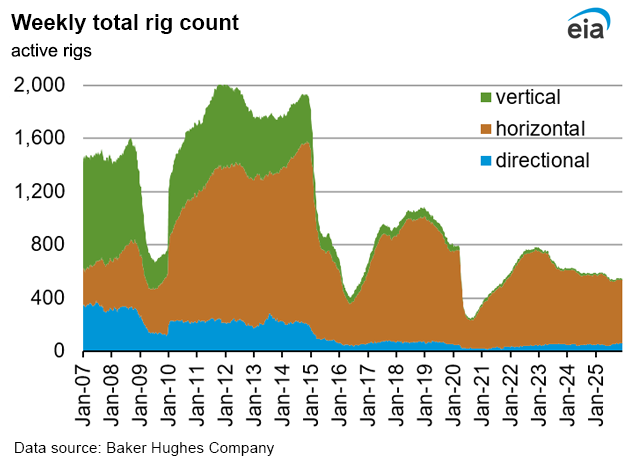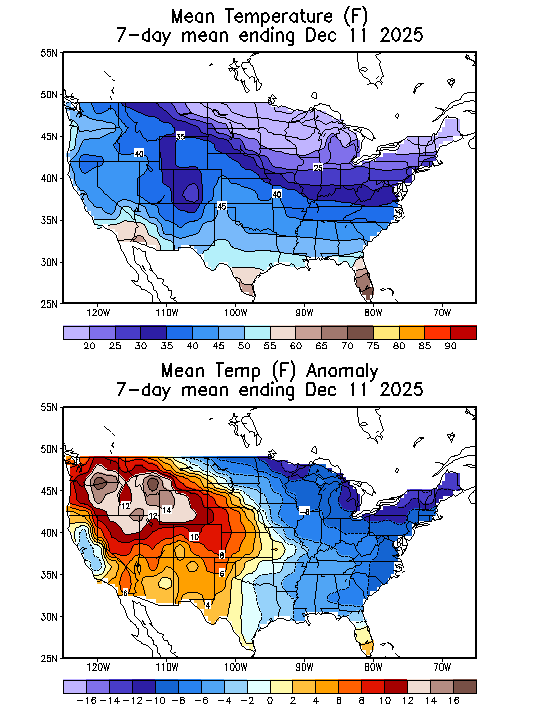Notice of holiday release schedule for Natural Gas Weekly Update (NGWU):
There will be no NGWU released on Thursday, December 25, or Thursday, January 1, due to the federal holidays. The next NGWU will be released on January 8, 2026.
Today in Energy
Recent Today in Energy analysis of natural gas markets is available on the EIA website.
Market Highlights:
(For the week ending Wednesday, December 17, 2025)Prices
- Henry Hub spot price: The Henry Hub spot price fell about 20% during the past week, or down 94 cents from $4.61 per million British thermal units (MMBtu) last Wednesday to $3.67/MMBtu yesterday.
- Henry Hub futures price: The price of the January 2026 NYMEX contract decreased 57 cents, from $4.595/MMBtu last Wednesday to $4.024/MMBtu yesterday. The price of the 12-month strip averaging January 2026 through December 2026 futures contracts declined 31 cents to $3.764/MMBtu. Natural gas futures prices have been volatile in December.
- Select regional spot prices: Guided by Henry Hub, spot natural gas prices fell at most locations this report week (Wednesday, December 10, to Wednesday, December 17). Price changes ranged from a decrease of $15.81 at the Algonquin Citygate to an increase of $3.72 at the Waha Hub.
- Prices across the South were mostly lower this week, in line with the Henry Hub, as temperatures rose toward the end of the week. The price at Florida Gas Zone 3 fell $1.11 from $5.22/MMBtu last Wednesday to $4.11/MMBtu yesterday. Yesterday’s price for this downstream zone into Florida was the second highest among major pricing hubs, trailing only Algonquin Citygate at $4.22/MMBtu. Total natural gas consumption in Florida fell 8% (0.3 billion cubic feet per day [Bcf/d]) from last week, according to LSEG Data. The price at the Houston Ship Channel fell $1.02 from $4.00/MMBtu last Wednesday to $2.98/MMBtu yesterday. Average temperatures in the Houston area were 57°F this report week, up 3°F from last week. Intraweek average temperatures reached a low of 43°F on December 15 before rising to end the week at 61°F on Wednesday. Residential and commercial sector consumption of natural gas in Texas fell 9% (0.3 Bcf/d) this week, according to LSEG Data. In addition, a 3% (0.5 Bcf/d) decrease in liquefied natural gas (LNG) feedgas deliveries to terminals along the Gulf Coast contributed to reduced natural gas demand on the Gulf Coast. The price at the Waha Hub in West Texas, which is located near Permian Basin production activities, rose $3.72 this report week, from -$3.35/MMBtu last Wednesday to $0.37/MMBtu yesterday. The Waha Hub’s discount to the Henry Hub shrank during the past week—transitioning to $3.30 below the Henry Hub price yesterday from $7.96 below the Henry Hub price last Wednesday. The El Paso Natural Gas Company concluded some maintenance activities on segments of its North Mainline and South Mainline this week, allowing more natural gas to flow out of the basin.
- International futures prices: International natural gas futures price changes were mixed this report week. According to Bloomberg Finance, L.P., weekly average front-month futures prices for LNG cargoes in East Asia decreased 63 cents to a weekly average of $10.22/MMBtu. Natural gas futures for delivery at the Title Transfer Facility (TTF) in the Netherlands increased 13 cents to a weekly average of $9.37/MMBtu. In the same week last year (week ending December 18, 2024), the prices were $13.78/MMBtu in East Asia and $12.73/MMBtu at TTF. Top
Daily spot prices by region are available on the EIA website.
Liquefied Natural Gas (LNG)
- Vessels departing U.S. ports: Thirty-three LNG vessels with a combined LNG-carrying capacity of 126 billion cubic feet (Bcf) departed the United States between December 11 and December 17, according to shipping data provided by Bloomberg Finance, L.P.:
- Nine tankers from Sabine Pass
- Six from Plaquemines
- Five from Corpus Christi
- Four each from Cameron and Freeport
- Three from Calcasieu Pass
- Two from Cove Point
- Vessels arriving at U.S. ports: Two LNG vessels with a carrying capacity of 8 Bcf docked for off-loading between December 11 and December 17, according to shipping data provided by Bloomberg Finance, L.P.:
- One tanker each from Golden Pass LNG and Cove Point. The tanker arriving at Golden Pass was this terminal’s initial cool-down cargo to facilitate the start of operations.
Rig Count
- According to Baker Hughes, for the week ending Tuesday, December 9, the natural gas rig count decreased by 2 rigs from a week ago to 127 rigs. The Arkoma Woodford dropped one rig, and six rigs were dropped among unidentified producing regions. The Haynesville added four rigs, and the Utica added one rig. The number of oil-directed rigs increased by 1 rig from a week ago to 414 rigs. The Granite Wash added two rigs, and the Ardmore Woodford and the Eagle Ford each added one rig. The Permian dropped two rigs, and the DJ-Niobrara dropped one rig. The total rig count, which includes 7 miscellaneous rigs, now stands at 548 rigs, 41 fewer than at this time last year.
Storage
- Net withdrawals from storage totaled 167 Bcf for the week ending December 12, compared with the five-year (2020–24) average net withdrawals of 96 Bcf and last year's net withdrawals of 134 Bcf during the same week. Working natural gas stocks totaled 3,579 Bcf, which is 32 Bcf (1%) more than the five-year average and 61 Bcf (2%) lower than last year at this time. Current inventories in the East and Midwest natural gas storage regions are about 5% under the five-year average.
See also:
Top
| Spot Prices ($/MMBtu) | Thu, 11-Dec |
Fri, 12-Dec |
Mon, 15-Dec |
Tue, 16-Dec |
Wed, 17-Dec |
|---|---|---|---|---|---|
| Henry Hub |
4.35 |
4.06 |
3.89 |
3.59 |
3.67 |
| New York |
6.84 |
17.05 |
10.90 |
3.94 |
3.65 |
| Chicago |
4.11 |
4.14 |
3.35 |
3.20 |
3.35 |
| Cal. Comp. Avg.* |
3.14 |
3.19 |
2.98 |
2.71 |
2.78 |
| *Avg. of NGI's reported prices for: Malin, PG&E Citygate, and Southern California Border Avg. | |||||
| Data source: NGI's Daily Gas Price Index | |||||


| Rigs | |||
|---|---|---|---|
Tue, December 09, 2025 |
Change from |
||
|
last week
|
last year
|
||
| Oil rigs |
414
|
0.2%
|
-14.1%
|
| Natural gas rigs |
127
|
-1.6%
|
23.3%
|
| Note: Excludes any miscellaneous rigs | |||
| Rig numbers by type | |||
|---|---|---|---|
Tue, December 09, 2025 |
Change from |
||
|
last week
|
last year
|
||
| Vertical |
16
|
6.7%
|
14.3%
|
| Horizontal |
478
|
0.4%
|
-9.0%
|
| Directional |
54
|
-6.9%
|
8.0%
|
| Data source: Baker Hughes Company |
|||
| Working gas in underground storage | ||||
|---|---|---|---|---|
Stocks billion cubic feet (Bcf) |
||||
| Region |
2025-12-12 |
2025-12-05 |
change |
|
| East |
797 |
843 |
-46 |
|
| Midwest |
966 |
1,030 |
-64 |
|
| Mountain |
271 |
277 |
-6 |
|
| Pacific |
304 |
306 |
-2 |
|
| South Central |
1,242 |
1,290 |
-48 |
|
| Total |
3,579 |
3,746 |
-167 |
|
|
Data source: U.S. Energy Information Administration Form EIA-912, Weekly Underground Natural Gas Storage Report Note: Totals may not equal sum of components because of independent rounding. | ||||
| Working gas in underground storage | |||||
|---|---|---|---|---|---|
Historical comparisons |
|||||
Year ago 12/12/24 |
5-year average 2020-2024 |
||||
| Region | Stocks (Bcf) |
% change |
Stocks (Bcf) |
% change |
|
| East |
827 |
-3.6 |
834 |
-4.4 |
|
| Midwest |
1,014 |
-4.7 |
1,014 |
-4.7 |
|
| Mountain |
275 |
-1.5 |
223 |
21.5 |
|
| Pacific |
297 |
2.4 |
268 |
13.4 |
|
| South Central | 1,226 |
1.3 |
1,208 |
2.8 |
|
| Total | 3,640 |
-1.7 |
3,547 |
0.9 |
|
| Data source: U.S. Energy Information Administration Form EIA-912, Weekly Underground Natural Gas Storage Report
Note: Totals may not equal sum of components because of independent rounding. |
|||||
| Temperature – heating & cooling degree days (week ending Dec 11) | ||||||||
|---|---|---|---|---|---|---|---|---|
HDDs |
CDDs |
|||||||
| Region | Current total |
Deviation from normal |
Deviation from last year |
Current total |
Deviation from normal |
Deviation from last year |
||
| New England | 280 |
61 |
50 |
0 |
0 |
0 |
||
| Middle Atlantic | 269 |
61 |
60 |
0 |
0 |
0 |
||
| E N Central | 289 |
51 |
60 |
0 |
0 |
0 |
||
| W N Central | 279 |
14 |
45 |
0 |
0 |
0 |
||
| South Atlantic | 189 |
44 |
24 |
7 |
-1 |
3 |
||
| E S Central | 182 |
32 |
14 |
0 |
-1 |
0 |
||
| W S Central | 115 |
4 |
6 |
0 |
-3 |
-1 |
||
| Mountain | 167 |
-51 |
-22 |
0 |
0 |
0 |
||
| Pacific | 69 |
-46 |
-18 |
0 |
-1 |
0 |
||
| United States | 206 |
19 |
28 |
1 |
-1 |
0 |
||
|
Data source: National Oceanic and Atmospheric Administration Note: HDDs=heating degree days; CDDs=cooling degree days | ||||||||
Average temperature (°F)
7-day mean ending Dec 11, 2025

Data source: National Oceanic and Atmospheric Administration
Deviation between average and normal temperature (°F)
7-day mean ending Dec 11, 2025

Data source: National Oceanic and Atmospheric Administration
Monthly U.S. dry shale natural gas production by formation is available in the
Short-Term Energy Outlook.
